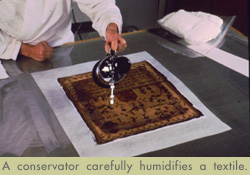 |
 |
 |
 |
 |
 |
                      
|
Restoration is always done in a manner that can be identified so that the old can be separated from the new. Sometimes the difference is visible to the naked eye; sometimes tools such as ultraviolet light may be necessary to identify the restoration. Conservation treatment is just one part of what conservators do. The steps described here, examination, stabilization, research, and restoration are part of a continuum of work. Preservation requires constant care and vigilance by everyone who cares for objects in institutions. Conservators use their understanding of materials and deterioration processes to develop better strategies for preventive care so that objects won't need treatment in the future.
|
|||
 Conservators do restoration to bring an object closer to its original state.
Often this means replacing missing parts and toning new parts
to match. For example, a conservator may fill holes and gaps in a ceramic
jar that was glued together from many pieces. Different types of fill
materials are used depending on the type of ceramic. Porcelain needs a very hard fill that can accept
a shiny surface. Low-fired ceramics are usually restored with a softer,
more porous material, such as plaster. Conservators color these fills
using various materials and techniques to match or blend with the
surface.
Conservators do restoration to bring an object closer to its original state.
Often this means replacing missing parts and toning new parts
to match. For example, a conservator may fill holes and gaps in a ceramic
jar that was glued together from many pieces. Different types of fill
materials are used depending on the type of ceramic. Porcelain needs a very hard fill that can accept
a shiny surface. Low-fired ceramics are usually restored with a softer,
more porous material, such as plaster. Conservators color these fills
using various materials and techniques to match or blend with the
surface.